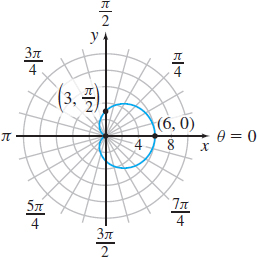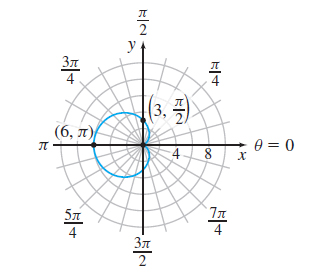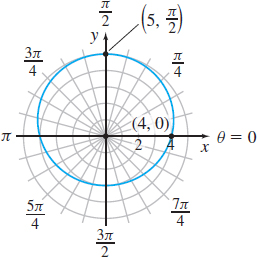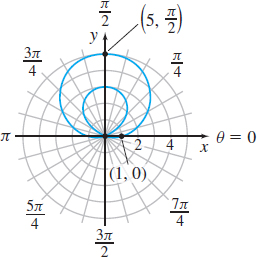9.5 Assess Your Understanding
Concepts and Vocabulary
Question
True or False A cardioid passes through the pole.
Question
Multiple Choice The equations for cardioids and limaçons are very similar. They all have the form \begin{equation*} r=a\pm b \ \cos \theta \qquad\hbox{or}\qquad r=a\pm b \ \sin \theta ,\;a>0, b>0 \end{equation*} The equations represent a limaçon with an inner loop if [(a) \(a\lt b\), (b) \(a>b\), (c) \(a= b]\); a cardioid if [(a) \(a\lt b\), (b) \(a>b\), (c) \(a= b];\) and a limaçon without an inner loop if [(a) \(a\lt b\), (b) \(a>b\), (c) \(a= b].\)
Question
True or False The graph of \(r=\sin ( 4\theta )\) is a rose.
Question
The rose \(r= \ \cos ( 3\theta )\) has __________ petals.
Skill Building
In Problems 5–12, for each polar equation:
(a) Graph the equation.
(b) Find parametric equations that represent the equation.
Question
\(r=2+2 \ \cos \theta\)
Question
\(r=3-3\sin \theta\)
Question
\(r=4-2 \ \cos \theta\)
Question
\(r=2+\sin \theta\)
Question
\(r=1+2\sin \theta\)
Question
\(r=2-3 \ \cos \theta\)
Question
\(r=\sin ( 3\theta )\)
Question
\(r=4 \ \cos ( 4\theta )\)
In Problems 13–18, graph each pair of polar equations on the same polar grid. Find polar coordinates of the point(s) of intersection and label the point(s) on the graph.
Question
\(r=8\cos \theta, \,\;\, r=2\sec \theta\)
Question
\(r=8\sin \theta,\,\;\, r=4\csc \theta\)
Question
\(r=\sin \theta, \,\;\, r=1+ \ \cos \theta\)
Question
\(r=3, \,\;\, r=2+2 \ \cos \theta\)
Question
\(r=1+\sin \theta, \,\;\, r=1+ \ \cos \theta\)
Question
\(r=1+ \ \cos \theta, \,\;\, r=3 \ \cos \theta\)
In Problems 19–22, find the arc length of each curve.
Question
\(r=f(\theta )=e^{\theta /2}\, \text{from} \,\theta = 0\, \text{to} \,\theta =2\)
Question
\(r=f(\theta )=e^{2\theta }\, \text{from} \,\theta = 0\, \text{to} \,\theta =2\)
Question
\(r=f(\theta )= \ \cos ^{2}\dfrac{\theta }{2}\, \text{from} \,\theta = 0\, \text{to} \,\theta =\pi\)
Question
\(r=f(\theta )=\sin ^{2}\dfrac{\theta }{2}\, \text{from} \,\theta = 0\, \text{to} \,\theta =\pi\)
Applications and Extensions
In Problems 23–26, the polar equation for each graph is either \(r=a+b \ \cos \theta\) or \(r=a+b \ \sin \theta ,\;a>0,\;b>0\). Select the correct equation and find the values of a and b.
Question

Question

Question

Question

In Problems 27–32, find an equation of the tangent line to each curve at the given number. (Hint: Find parametric equations that represent each polar equation. See Section 9.2.)
Question
\(r=2 \ \cos ( 3\theta )\, \text{at} \,\theta =\dfrac{\pi }{6}\)
Question
\(r=3\sin ( 3\theta )\, \text{at} \,\theta =\dfrac{\pi }{3}\)
Question
\(r=2+ \ \cos \theta\, \text{at} \,\theta =\dfrac{\pi }{4}\)
Question
\(r=3-\sin \theta\, \text{at} \,\theta =\dfrac{\pi }{6}\)
677
Question
\(r=4+5\sin \theta\, \text{at} \,\theta =\dfrac{\pi }{4}\)
Question
\(r=1-2 \ \cos \theta\, \text{at} \,\theta =\dfrac{\pi }{4}\)
Lemniscates Graphs of polar equations of the form \(r^{2}=a^{2} \ \cos ( 2\theta )\) or \(r^{2}=a^{2}\sin ( 2\theta )\), where \(a\neq 0\), are called lemniscates. A lemniscate passes through the pole twice and is shaped like the infinity symbol \(\infty .\)
In Problems 33–36, for each equation:
(a) Graph the lemniscate.
(b) Find parametric equations that represent the equation.
Question
\(r^{2}=4 \ \sin ( 2\theta )\)
Question
\(r^{2}=9 \ \cos ( 2\theta )\)
Question
\(r^{2}= \ \cos ( 2\theta )\)
Question
\(r^{2}=16 \ \sin ( 2\theta )\)
In Problems 37–48:
(a) Graph each polar equation.
(b) Find parametric equations that represent each equation.
Question
\(r=\dfrac{2}{1- \ \cos \theta }\) (parabola)
Question
\(r=\dfrac{1}{1- \ \cos \theta }\) (parabola)
Question
\(r=\dfrac{1}{3-2 \ \cos \theta }\) (ellipse)
Question
\(r=\dfrac{2}{1-2 \ \cos \theta }\) (hyperbola)
Question
\(r=\theta\); \(\theta \geq 0\) (spiral of Archimedes)
Question
\(r=\dfrac{3}{\theta }\); \(\theta >0\) (reciprocal spiral)
Question
\(r=\csc \theta -2; 0\lt\theta \lt\pi\) (conchoid)
Question
\(r=3-\dfrac{1}{2}\csc \theta\) (conchoid)
Question
\(r=\sin \theta \tan \theta\) (cissoid)
Question
\(r= \ \cos \dfrac{\theta }{2}\)
Question
\(r=\tan \theta\) (kappa curve)
Question
\(r=\cot \theta\) (kappa curve)
Question
Show that \(r=4(\cos \theta +1)\) and \(r=4(\cos \theta -1)\) have the same graph.
Question
Show that \(r=5(\sin \theta +1)\) and \(r=5(\sin \theta -1)\) have the same graph.
Question
Arc Length Find the arc length of the spiral \(r=\theta\) from \(\theta =0\) to \(\theta =2\pi\).
Question
Arc Length Find the arc length of the spiral \(r=3\theta\) from \(\theta =0\) to \(\theta =2\pi .\)
Question
Perimeter Find the perimeter of the cardioid \(r=f(\theta )=1- \ \cos \theta ,\) \(-\pi \leq \theta \leq \pi \).
Question
![]() Exploring Using Graphing Technology
Exploring Using Graphing Technology
- Graph \(r_{1}=2 \ \cos ( 4\theta ) .\) Clear the screen and graph \(r_{2}= 2 \ \cos ( 6\theta ) .\) How many petals does each of the graphs have?
- Clear the screen and graph, in order, each on a clear screen, \(r_{1}=2 \ \cos ( 3\theta ),\;r_{2}=2 \ \cos ( 5\theta )\), and \(r_{3}=2 \ \cos ( 7\theta )\). What do you notice about the number of petals? Do the results support the definition of a rose?
Question
![]() Exploring Using Graphing Technology Graph \(r_{1}=3-2 \ \cos \theta\). Clear the screen and graph \(r_{2}=3+2 \ \cos \theta\). Clear the screen and graph \(r_{3}=3+2\sin \theta .\) Clear the screen and graph \(r_{4}=3-2\sin \theta .\) Describe the pattern.
Exploring Using Graphing Technology Graph \(r_{1}=3-2 \ \cos \theta\). Clear the screen and graph \(r_{2}=3+2 \ \cos \theta\). Clear the screen and graph \(r_{3}=3+2\sin \theta .\) Clear the screen and graph \(r_{4}=3-2\sin \theta .\) Describe the pattern.
Question
Horizontal and Vertical Tangent Lines Find the horizontal and vertical tangent lines of the cardioid \(r=1-\sin \theta\) discussed in Example 1.
Question
Horizontal and Vertical Tangent Lines Find the horizontal and vertical tangent lines of the cardioid \(r=3+3 \ \cos \theta\).
Question
![]() Horizontal and Vertical Tangent Lines Find the horizontal and vertical tangent lines of the limaçon with an inner loop \(r=1+2 \ \cos \theta\) discussed in Example 3.
Horizontal and Vertical Tangent Lines Find the horizontal and vertical tangent lines of the limaçon with an inner loop \(r=1+2 \ \cos \theta\) discussed in Example 3.
Question
![]() Horizontal and Vertical Tangent Lines Find the horizontal and vertical tangent lines of the rose with four petals \(r=2 \ \cos ( 2\theta ),\;0\leq \theta \leq 2\pi\), discussed in Example 4.
Horizontal and Vertical Tangent Lines Find the horizontal and vertical tangent lines of the rose with four petals \(r=2 \ \cos ( 2\theta ),\;0\leq \theta \leq 2\pi\), discussed in Example 4.
Question
![]() Horizontal and Vertical Tangent Lines Find the horizontal and vertical tangent lines of the spiral \(r=e^{\theta /5}\) discussed in Example 5.
Horizontal and Vertical Tangent Lines Find the horizontal and vertical tangent lines of the spiral \(r=e^{\theta /5}\) discussed in Example 5.
Question
![]() Horizontal and Vertical Tangent Lines Find the horizontal and vertical tangent lines of the lemniscate \(r^{2}=4\,\sin\,( 2\theta )\).
Horizontal and Vertical Tangent Lines Find the horizontal and vertical tangent lines of the lemniscate \(r^{2}=4\,\sin\,( 2\theta )\).
Question
Test for Symmetry Symmetry with respect to the polar axis can be tested by replacing \(\theta\) with \(-\theta .\) If an equivalent equation results, the graph is symmetric with respect to the polar axis.
- Explain why this test is valid.
- Use the test to show that \(r=3+2 \ \cos \theta\) is symmetric with respect to the polar axis.
Question
Test for Symmetry Symmetry with respect to the pole can be tested by replacing \(r\) by \(-r\) or by replacing \(\theta\) by \(\theta +\pi .\) If either substitution produces an equivalent equation, the graph is symmetric with respect to the pole.
- Explain why these tests are valid.
- Show that \(r^{2}=4 \ \sin\, ( 2\theta )\) is symmetric with respect to the pole.
Question
Test for Symmetry Symmetry with respect to the line \(\theta =\dfrac{\pi }{2}\) can be tested by replacing \(\theta\) by \(\pi -\theta .\) If an equivalent equation results, the graph is symmetric with respect to the line \(\theta =\dfrac{\pi }{2}\).
- Explain why this test is valid.
- Use the test to show that \(r=2 \ \cos ( 2\theta )\) is symmetric with respect to the line \(\theta =\dfrac{\pi }{2}\).
Challenge Problems
Tests for Symmetry The three tests for symmetry described in Problems 62–64 are sufficient conditions for symmetry, but they are not necessary conditions. That is, an equation may fail these tests and still have a graph that is symmetric with respect to the polar axis, the line \(\theta =\dfrac{\pi }{2}\), or the pole.
Question
Testing for Symmetry The graph of \(r=\sin ( 2\theta )\) (a rose with four petals) is symmetric with respect to the polar axis, the line \(\theta =\dfrac{\pi }{2}\), and the pole. Show that the test for symmetry with respect to the pole (see Problem 63) works, but the test for symmetry with respect to the polar axis fails (see Problem 62).
678
Question
Arc Length Find the entire arc length of the curve \(r=a \ \sin ^{3}\dfrac{\theta }{3},\) \(a>0\). (Hint: Use parametric equations.)
Question
![]() Arc Length of a Rose Petal
Arc Length of a Rose Petal
- Graph the rose \(r=4\sin ( 5\theta )\).
- The petal in the first quadrant begins when \(\theta =0\) and ends when \(\theta =\alpha .\) Find \(\alpha .\)
- Find the length \(s\) of the petal described in (b).
